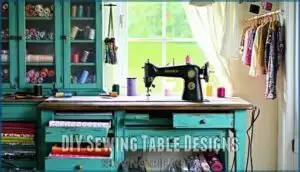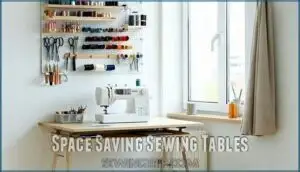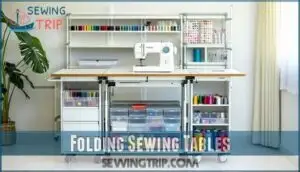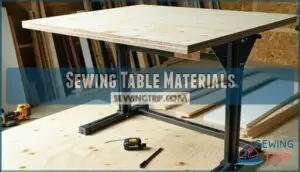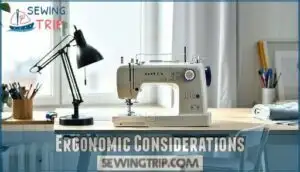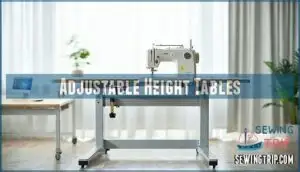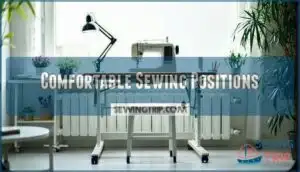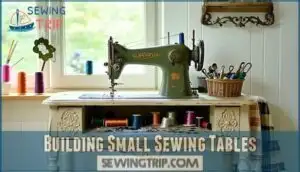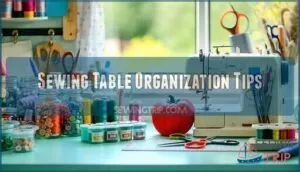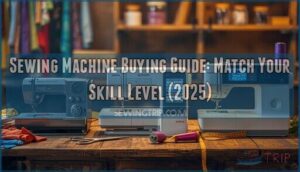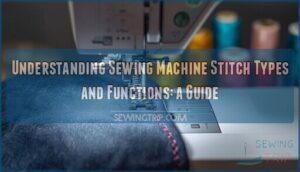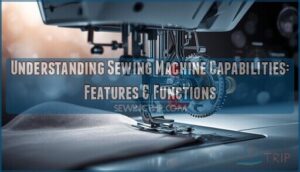This site is supported by our readers. We may earn a commission, at no cost to you, if you purchase through links.
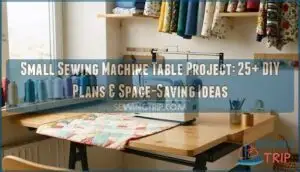
Start with a simple rectangular frame, then add features like drop-down extensions for large quilts or pull-out drawers for notions. Consider your ceiling height when planning vertical storage – most sewers overlook this essential detail.
A 29-inch table height works for most people, but you can customize based on your chair and posture preferences. Simple construction techniques and clever storage solutions can transform any corner into a productive sewing haven.
This project allows for customization to fit your specific needs, ensuring that your sewing area is both functional and comfortable.
Table Of Contents
Key Takeaways
- Measure your machine dimensions and add 4-6 inches on each side – You’ll create adequate workspace while ensuring your table fits your specific sewing machine perfectly.
- Plan for a 29-inch table height as your starting point – You can customize based on your chair and posture, but this height works for most sewers and prevents back strain.
- Include fold-down extensions and storage drawers – You’ll maximize functionality in small spaces with features like drop-down surfaces for large quilts and pull-out compartments for notions.
- Use basic materials like plywood and 2x4s to keep costs under $50 – You don’t need expensive materials or advanced woodworking skills to build a functional sewing table that rivals store-bought options.
Small Sewing Table Plans
You’ll find dozens of clever small sewing table plans that transform cramped spaces into efficient crafting zones.
These compact designs pack maximum functionality into minimal square footage, featuring fold-down surfaces, hidden storage, and wheels for easy repositioning, which includes efficient crafting zones.
DIY Sewing Table Designs
Creating your own sewing table transforms any workspace into a crafting command center.
You’ll discover endless possibilities when you embrace repurposed materials and antique cabinets for unique DIY sewing table projects. You can also find various table options online.
- Sunken Tables: Drop-in hacks turn ordinary dining tables into custom surfaces for seamless machine integration
- Antique Revival: Transform vintage cabinets into functional homemade sewing table masterpieces with built-in charm
- IKEA Innovations: Combine countertops with Alex drawers for affordable custom sewing table plans under $200
- Plywood Powerhouse: Build sturdy small sewing machine table designs using basic woodworking skills and minimal tools
Space Saving Sewing Tables
Apartment sewing enthusiasts need clever solutions when floor space is limited.
Wall-mounted tables fold against walls when not in use, while closet conversion transforms unused storage into compact sewing stations.
Portable options on wheels move easily between rooms. Multi-purpose furniture doubles as dining tables or desks.
A small sewing machine table with built-in storage maximizes every square inch of your spacesaving sewing solutions setup.
Consider using pegboards for tool storage to maximize vertical space and create a more efficient sewing station.
Folding Sewing Tables
Folding sewing machine tables maximize your workspace when needed, then tuck away neatly afterward.
These adjustable folding sewing tables feature sturdy folding leg braces and reliable locking mechanisms that secure your setup during use.
Material durability matters—look for reinforced hinges and solid construction that won’t wobble mid-project.
Assembly complexity varies, but most designs snap together quickly.
Storage integration keeps supplies organized within reach, while portability factors let you craft anywhere in your home, considering the overall material durability.
Sewing Table Materials
Material selection makes or breaks your sewing table project. You’ll need sturdy options that handle daily use without breaking your budget or your back.
- Plywood and Pine – Budget-friendly wood durability for frames, though pine scratches easily during heavy cutting work
- Laminate Options – Moisture resistance beats solid wood, plus ergonomic edges prevent wrist strain during long sessions
- Metal Supports – Steel legs eliminate wobble under heavy machines, supporting up to 50 pounds without vibration issues.
Many sewers find a suitable plywood sewing table meets their needs.
Sewing Machine Table Height
Getting the right sewing machine table height prevents back strain and keeps your stitches accurate during long projects.
You’ll want your tabletop 2-3 inches below your elbow when you’re seated with relaxed shoulders.
Ergonomic Considerations
Your sewing table ergonomic setup directly impacts your comfort during long projects.
Position your chair so your elbows bend at 90 degrees, keeping wrists straight for Posture Support.
Good Lighting Impact prevents eye strain and supports Vision Health.
Keep frequently used tools within comfortable Reach Distance to minimize stretching.
An ergonomic design promotes Fatigue Reduction during extended sewing sessions.
Experts suggest that optimal table height should match elbow height when seated.
Adjustable Height Tables
Beyond basic fixed-height designs, adjustable sewing table options transform your workspace into an ergonomic powerhouse.
Electric motors and manual crank systems deliver quiet, precise height changes between 28-48 inches, supporting both seated and standing work positions.
- Motorized lifts with memory presets instantly recall your favorite heights
- Standing desks combat back pain from hunched-over sewing marathons
- Programmable controls let multiple users save their perfect positions
- Anti-collision sensors prevent accidental pinching during adjustments
These adjustable sewing table designs offer serious posture improvement benefits.
Small sewing desk plans incorporating height adjustment mechanisms help you avoid the chronic aches that plague dedicated sewists.
A dual-motor system facilitates smooth height transitions for ease of use.
Whether you’re following existing sewing table plans or creating custom sewing table design solutions, motorized systems provide the ergonomic benefits your back craves.
Smart sewing table ideas integrate these features seamlessly into compact workspaces.
Comfortable Sewing Positions
Good ergonomic habits keep your shoulders relaxed and elbows at ninety degrees.
Your adjustable ergonomic table should align with your chair height, creating proper posture support.
Position your sewing desk eighteen to twenty-four inches from your body.
Chair ergonomics matter—your feet should rest flat on the floor.
Good lighting impact reduces eye strain, while regular breaks frequency prevents stiffness and maintains comfort during long sewing sessions, ensuring proper posture support is maintained throughout.
Compact Sewing Table Features
Smart storage features turn your compact sewing table into an organizational powerhouse that keeps everything within arm’s reach.
You’ll maximize every square inch with foldable extensions, hidden compartments, and clever multifunctional designs that adapt to your changing project needs.
Storage Options
Smart storage transforms your sewing table with storage from cluttered chaos into an organized workspace. Four easy-glide drawers conceal notions while sliding thread shelves secure 2.75-inch spools dust-free. Self-closing mechanisms maintain order in your small sewing projects area.
Smart drawers and sliding shelves transform sewing chaos into organized bliss.
A foldable design is ideal for space-saving when the table isn’t in use.
- Drawer Dividers: Separate bobbins, buttons, and measuring tools in pull-out compartments
- Pegboard Organization: Mount scissors, rulers, and rotary cutters on vertical side panels
- Cabinet Inserts: Install adjustable shelves for sewing machine storage and cleaning supplies
- Shelf Placement: Position fabric bins on lower tiers for quick access without bending
- Sewing Organizer: Use magnetic strips for pins and clips on table edges
Foldable Extensions
When your workspace needs grow, expandable wings transform compact tables into cutting powerhouses.
Drop-leaf mechanisms and folding arms create instant workspace without permanent floor space commitment.
These tables can substantially increase your sewing workspace size, which is ideal for larger projects.
| Feature | Benefit | Stability Rating | Best For |
|---|---|---|---|
| Piano hinges | Smooth operation | Excellent | Heavy fabric cutting |
| Drop-leaf supports | Quick setup | Good | Occasional large projects |
| Folding arms | Space maximization | Fair | Lightweight materials |
| Locking brackets | Extension stability | Excellent | Precision work |
Your foldable sewing table gains 50% more surface area instantly.
Quality hinge durability guarantees years of reliable expansion.
Portable sewing becomes effortless when wings fold flat for transport or storage in small space sewing setups, allowing for effortless transport and precision work.
Hidden Compartments
Hidden compartments turn your small sewing machine table into a treasure chest of secret storage.
Flip-top compartments hide thread collections, while concealed drawers with false bottoms stash sharp tools safely.
DIY sewing table designs benefit from locking compartments that protect expensive supplies.
You’ll maximize storage solutions without sacrificing your compact workspace’s clean appearance.
Multifunctional Designs
Multifunctional designs transform your cramped craft corner into a productivity powerhouse.
These dual-purpose tables serve as sewing desk, craft station, and regular workspace.
Convertible sewing surfaces flip between flatbed and free-arm configurations.
Integrated ironing boards pop up when needed.
Foldable sewing table designs include hidden features like charging ports and adjustable heights, making small space sewing effortless and organized, with a focus on multifunctional use.
Building Small Sewing Tables
You’ll find building a small sewing table easier than wrestling with fabric on your kitchen counter every weekend.
These projects range from simple $34 desk conversions to advanced custom builds with hidden storage that’ll make your sewing friends jealous.
Beginner Friendly Plans
Starting with beginner-friendly DIY sewing table plans opens doors to your first woodworking success.
The Easy Desk Plan costs just $34 and requires minimal skill—perfect for newcomers.
Try a Simple Wooden Design using basic tools, or tackle an Antique Cabinet Upcycle for character.
These low cost tables prove that beginnerfriendly doesn’t mean compromising quality in small space sewing projects, making it a great way to achieve woodworking success.
Advanced Woodworking Projects
Experienced woodworkers can tackle sophisticated sewing machine table projects featuring complex joinery techniques like dovetails and mortise-and-tenon connections.
These advanced woodworking projects incorporate exotic woods such as walnut or cherry, CNC integration for precision cuts, and veneer application for stunning finishes.
Intricate carving details and custom hardware elevate these builds beyond basic intermediate woodworking experience requirements, incorporating techniques like mortise-and-tenon connections and featuring exotic woods.
Customization Ideas
You’re the artist behind your custom sewing table design.
Surface finishes like Bombay Mahogany stain or crisp white paint set the mood. Leg styles range from hairpin legs to trestle bases.
Added features like fold-down ironing boards or pegboard panels boost functionality. Personal touches matter – carve initials or add fabric integration through padded armrests.
Your sewing table ideas should reflect your style and workspace needs perfectly, with considerations for functionality.
Budget Friendly Options
You don’t need deep pockets for sewing table ideas.
Thrift store finds offer solid bases for under $50.
Repurposed materials like discount lumber and pallet projects stretch budgets further.
IKEA components create budget-friendly DIY sewing table solutions around $100.
Affordable hardware from local stores keeps costs minimal while delivering maximum functionality for your sewing table budget with repurposed materials.
Sewing Table Organization Tips
You’ll maximize your small sewing table’s potential by implementing smart organization systems that keep everything within arm’s reach.
These storage solutions turn cramped spaces into efficient crafting zones where every thread, bobbin, and tool has its designated spot, making the space an efficient crafting zone.
Vertical Storage Solutions
Maximize your sewing machine table’s storage potential by mounting pegboard organization systems on side panels.
Install magnetic strips underneath for scissors and small tools. Add slide-out trays for easy access to supplies without opening lockable cabinets.
These vertical solutions transform dead wall space into functional sewing organization zones, keeping your sewing room ideas clutter-free while maintaining storage space efficiency and creating a more organized area with vertical solutions.
Thread Spool Management
Multiple thread dispensers keep your spools organized and accessible during projects.
Install magnetic strips on your sewing table’s side panels for metal spools, or add wooden dowel racks for plastic ones.
Color coordination makes thread selection faster—arrange spools by hue or project type.
Drawer dividers create dedicated spool storage sections, while an inventory system tracks your thread collection efficiently, allowing for better thread selection.
Bobbin Storage Ideas
Chaos disappears when you organize your bobbins properly, creating a streamlined sewing experience.
Effective bobbin organization keeps your sewing supplies accessible and your storage area tidy.
- Create a color coding system – Match bobbins to thread spools using small stickers or numbered labels for quick thread pairing identification.
- Use portable storage solutions – Small tackle boxes or magnetic bobbin holders keep bobbins secure and easily transportable between your sewing table and bobbin winders.
- Install drawer dividers – Compartmentalized sewing accessories storage prevents bobbins from tangling and maintains your sewing table organization system efficiently.
Workspace Optimization Techniques
Beyond organizing bobbins, strategic workspace organization transforms your compact sewing furniture into an efficiency powerhouse.
Position your cutting mat at elbow height for ergonomic layout comfort. Install LED lighting solutions directly above your work area to boost brightness by 30%.
Keep scissors and rulers within arm’s reach through smart tool placement. Proper planning includes setting organizational goals for an efficient space.
Clear surfaces regularly for clutter reduction and improved workflow efficiency in your sewing workspace.
Frequently Asked Questions (FAQs)
Are there sewing machine table plans?
Yes, you’ll find plenty of sewing machine table plans available. Options range from simple $34 beginner-friendly designs to advanced custom builds with storage drawers and adjustable heights for ergonomic comfort.
What are DIY sewing table plans?
DIY sewing table plans offer step-by-step instructions for building custom workspace solutions.
You’ll find designs ranging from simple IKEA hacks to advanced woodworking projects, featuring folding surfaces, storage drawers, and ergonomic heights suited to your space, with custom workspace solutions being the primary goal.
What are the best small crafting/sewing tables?
Go for a fold-down table with locking caster wheels and built-in cubbies.
You’ll love a hairpin leg design or an IKEA Kallax hack.
Pre-cut lumber, melamine tops, and drop-leaf hinges keep your sewing kit tidy and mobile.
What is a small sewing table?
A small sewing table is a compact workspace designed for tight spaces, typically under 36" wide.
You’ll get storage drawers, foldable extensions, and enough surface area for your machine plus cutting tasks, which makes it a great option for those who need a compact workspace.
What is a DIY sewing machine table?
Picture Rosie the Riveter crafting her perfect workspace—that’s you building a DIY sewing machine table.
You’re creating a custom workspace using basic materials like plywood, pine, or MDF that perfectly fits your machine and storage needs.
What is a cutting & sewing table plan?
A cutting & sewing table plan combines workspace for both fabric cutting and machine sewing in one design.
You’ll get detailed instructions, measurements, and material lists to build a dual-purpose table that maximizes your crafting efficiency.
What is the easiest thing to make with a sewing machine?
Like a gentle breeze lifting your first sail, straight lines become your best friend when you’re starting out.
You’ll master simple tote bags or pillowcases quickly—they’re forgiving, require basic stitches, and build confidence without complex curves or tricky techniques.
Can a mini sewing machine sew jeans?
Most mini sewing machines can’t handle denim’s thickness effectively. You’ll struggle with multiple seams, hems, and heavy-duty stitching. Regular machines with stronger motors work better for jeans.
Do it yourself DIY sewing table?
You can build a DIY sewing table using basic materials like plywood, IKEA components, or repurposed furniture. Start with simple plans requiring minimal tools and skills for under $
What height should a sewing machine table be?
Your perfect sewing table height will absolutely transform your stitching experience! Measure from floor to your elbow while seated – that’s your ideal height, typically 28-30 inches for most sewers.
Conclusion
Countless sewers believe they need expensive commercial tables, but your small sewing machine table project proves otherwise.
With basic materials and simple techniques, you’ll create a workspace that rivals store-bought options at half the cost.
Your custom dimensions guarantee perfect ergonomics while clever storage keeps supplies organized.
Whether you choose folding designs for tight spaces or stationary tables with hidden compartments, you’ll discover that thoughtful planning beats expensive equipment.
Start measuring your space today—your perfect sewing table awaits construction.

